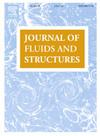基于WMLES的三维气动弹性求解器预测激波湍流边界层相互作用下夹固弹性板的运动
IF 3.5
2区 工程技术
Q1 ENGINEERING, MECHANICAL
引用次数: 0
摘要
研究了高雷诺数激波冲击柔性薄板时流固相互作用的松耦合预测方法。采用壁式大涡模拟(LES)求解流体域,并将得到的时间分辨流场作为理论-计算气动弹性求解器的输入。计算研究模拟了现有实验的流动和结构条件,以便对面板的位移进行比较。该方法是对现有理论计算模型的改进。例如,最大静态变形的预测,这是一个关键指标,显示在实验结果的10%以内。正如Freydin等人所指出的那样,对面板随时间振荡的预测显示出对提供给气动弹性求解器的相干长度的敏感性。预测的随时间变化的面板振荡幅度与实验中观察到的差异,假设是由于方法中缺乏瞬时耦合,或者可能是由于风洞在整个运行过程中静压的变化。本文章由计算机程序翻译,如有差异,请以英文原文为准。
Prediction of clamped–clamped elastic panel motion under influence of shock-wave turbulent boundary layer interactions using WMLES with a 3D aeroelastic solver
A loosely coupled approach for the prediction of fluid–structure interactions is investigated for a high Reynolds number flow with a shock-wave impinging on a thin flexible panel. The fluid domain is solved using a wall-modeled large eddy simulation (LES), and the resulting time-resolved flowfields are provided as input to a theoretical–computational aeroelastic solver. The computational study mimics the flow and structural conditions of an existing experiment such that the panel displacements can be compared. The approach shows an improvement over an existing theoretical–computational model. For example, predictions of the maximum static deformation, which is a key metric, are shown to be within 10% of the experimental result. Predictions of the time-dependent oscillations of the panel show sensitivity to the coherence length provided to the aeroelastic solver, as noted by Freydin et al. The discrepancy in the magnitude of predicted time-dependent panel oscillations and those observed in the experiment is hypothesized to be due to the lack of instantaneous coupling present in the method, or possibly due to variability in the static pressure of the wind tunnel throughout the run.
求助全文
通过发布文献求助,成功后即可免费获取论文全文。
去求助
来源期刊

Journal of Fluids and Structures
工程技术-工程:机械
CiteScore
6.90
自引率
8.30%
发文量
173
审稿时长
65 days
期刊介绍:
The Journal of Fluids and Structures serves as a focal point and a forum for the exchange of ideas, for the many kinds of specialists and practitioners concerned with fluid–structure interactions and the dynamics of systems related thereto, in any field. One of its aims is to foster the cross–fertilization of ideas, methods and techniques in the various disciplines involved.
The journal publishes papers that present original and significant contributions on all aspects of the mechanical interactions between fluids and solids, regardless of scale.
 求助内容:
求助内容: 应助结果提醒方式:
应助结果提醒方式:


